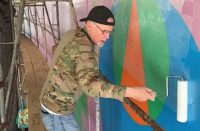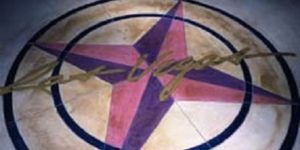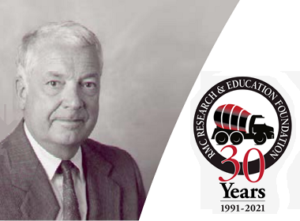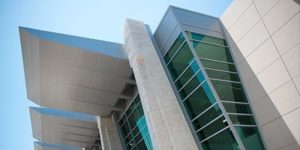Can a major axis of modern transportation infrastructure in Los Angeles somehow forge a tie to the region’s pre-modern heritage?
The Metro Gold Line Extension Construction Authority, which is building a major addition to a new light-rail line stretching from Pasadena to Montclair, California, thinks so. The construction authority made creativity in transportation architecture — and concrete construction — a priority in the design of a light-rail bridge spanning Interstate 210 at Arcadia.
The Gold Line Bridge, the first-ever artist-designed transit bridge in California, is described as a 584-foot-long concrete sculpture, a project that has “reimagined the construction process for transit infrastructure projects in the state,” the Construction Authority says in a news release.
The concept for bridge as art was inspired by the region’s indigenous peoples and wildlife, accented with the relatively contemporary historical flavor of the nearby U.S. Route 66 “with its oversized architectural landmarks,” according to the Construction Authority’s written account of the project, titled “Gold Line Bridge: The Art of Design.”
Andrew Leicester, the artist commissioned as design concept advisor for the project, says the shapes of woven baskets adorning the bridge “metaphorically represent the Native Americans of the region and the growth of agriculture as a primary catalyst to the San Gabriel Valley.” Leicester has created a number of notable public art pieces over the past 30 years, including projects at transit plazas, park entrances, water gardens and other venues.
The bridge structure’s serpentine main underbelly features cast grooves and hatch marks simulating the patterns seen on the western diamondback rattlesnake, which the Construction Authority says is a reference to the connectivity of the transit system.
Building the baskets
Moonlight Molds, of Gardena, California, produced the precast concrete elements that formed two focal pieces in the bridge sculpture: the 25-foot-tall “woven” baskets. These two elements are visually tied together by a relief pattern on the span’s outrigger beam. The complex weaving patterns on the beam and the ribbed pattern on the superstructure were created using wood and rubber concrete forms crafted by Fitzgerald Formliners of Santa Ana.
Masonry Concepts, a diversified masonry construction subcontractor with an extensive portfolio of major projects in Southern California, took on the pivotal role of assembling the parts to create the baskets.
Skanska USA Civil, the primary construction contractor, built the concrete-and-steel-rebar columns on which the basket elements were assembled. Masonry Concepts’ task was to lift the 60-some precast concrete parts into place, connect them to the rebar mat that served as a framework for attaching the basket and reinforcing for the grout installed behind the basket sections. The mat consisted of 8-by-8-inch squares of vertical and horizontal rebar.
“This wasn’t a huge job for us, but certainly one of the more unique,” says Dana Kemp, president of Masonry Concepts and project manager for the company’s work on the bridge. “It’s a unique kind of job for masonry contractors of this type. The men like to be involved in something like that. Laying 8-8-16 structural block all day long can get old,” he quips.
“Also, I like to pursue projects like that. The men like it, and it’s an opportunity to see greater (profit) margin. There’s more risk, but more reward potential.”
A key to Masonry Concepts’ successful bid for the masonry subcontract work, Kemp says, was the company’s innovative approach in devising a system to effectively attach the concrete basket elements to the rebar-mesh framework. This system involved two all-thread rods threaded into inserts cast into the back of the precast parts and bolting two C channels to the ends of the all-thread, with the rebar mat sandwiched between the precast basket segments and the C channel.
“We came up with a better mousetrap,” Kemp says of the system used to attach the basket parts to the steel framework. “Our system allowed us to access the back of the part and the rebar directly from the scaffold. The lengths of all thread were all within a typical length that we were able to precut. There was virtually no drilling — simply setting and aligning the part, then bolting on the C-channel and snugging it up against the rebar mat that needed to be there anyway for reinforcing the grout pour.”
Each horizontal ring of the woven baskets is composed of eight concrete sections, each measuring 7 feet long, 1 foot 9 inches high and 12 inches thick from front to back. Kemp estimated that each part weighed more than 1,000 pounds. About 10 rings were stacked atop one another to make the baskets.
Debating the concrete mix design
While the system to attach the basket parts got a good deal of attention from the standpoint of structural challenges, the concrete mix used for the bridge’s artwork elements generated considerable discussion and was the subject of extensive review by the design team.
“It required several different types and colors of aggregate,” says Lawrence Demore, Skanska’s project manager for the bridge construction. Demore says the mix went through several samples before winning approval from the design team.
Jeff Keenan, president and owner of Moonlight Molds, says the company incorporated locally sourced black-stone aggregate to produce a mix that provided both the appearance and the connection to the region’s geology sought by the designers. Ground glass — clear, gray and mirrored — was added to produce the sparkle the designers wanted, he says.
To optimize aggregate exposure on the precast elements that make up the basket sculptures, Moonlight Molds used a special release agent, and water was employed for a final blast treatment instead of abrasive media.
Erecting the reeds
Also generating buzz at the project discussion sessions was the challenge of casting the parts that serve as the “reeds” extending from the tops of the two basket elements. Concerns were raised about producing these slender columns in a way that met visual objectives while remaining intact in demanding service conditions. Kemp says steel tubing painted to match the baskets’ finish was suggested, but dismissed by the designers. They wanted an authentic replication of the composition used in the basket sculpture.
Here, Keenan says Moonlight Molds used a steel tube and flex anchor framework to provide structural integrity. The concrete exterior of these elements is composed of GFRC and an aggregate mix identical to the concrete used for the basket elements.
Melding art and transit
The bridge is a key part of the Foothill Extension, a nearly $2 billion, 24-mile extension of the Metro Gold Line light-rail system. The section from Pasadena to Azusa is scheduled for completion in September 2015. The Azusa-to-Montclair section is still in planning.

The Gold Line Bridge was completed in late 2012 and has won five industry awards for construction and engineering excellence. Construction Authority CEO Habib F. Balian says the bridge’s cost of $18.6 million is roughly the same as that of a conventional bridge.
In press materials, Balian says the design and construction project team succeeded in creating what he envisioned — a bridge that is “sculptural, not just an embellished structure.“
“I wanted us to create something fantastic, something never done before. I wanted the artist to address the landscape — the mountains — as well as the community and its history and culture. Ultimately, I wanted to meld art and the transit experience, and we did that.”
Project at a Glance
Client: Metro Gold Line Extension Construction Authority
Concrete construction contractor: Skanska USA Civil | www.usa.skanska.com
Masonry construction subcontractor: Masonry Concepts Inc., Santa Fe Springs, California | www.masonry-concepts.com
Cast-concrete parts maker: Moonlight Molds, Gardena, California | www.moonlightmolds.com
Concrete forms supplier: Fitzgerald Formliners, Santa Ana, California | www.formliners.com
Architect/design consultant: AECOM, Los Angeles | www.aecom.com
Scope of project: Construction of 584-foot-long light-rail bridge featuring sculptural design spanning Interstate 210. The project involved casting and construction of precast and cast-on-site concrete elements for 25-foot-tall basket designs and an underbelly of bridge span made to simulate the patterns of the western diamondback rattlesnake.
Project cost: $18.6 million
Project duration: About 16 months
Most challenging aspects: Installation of precast concrete elements to rebar-mesh framework of sculptural baskets; formulation of concrete mix and making of precast concrete elements with specified appearance qualities; design and casting of “reed” elements for baskets
Concrete mix: National Ready Mixed Concrete Co., Irwindale, California; Moonlight Molds






















